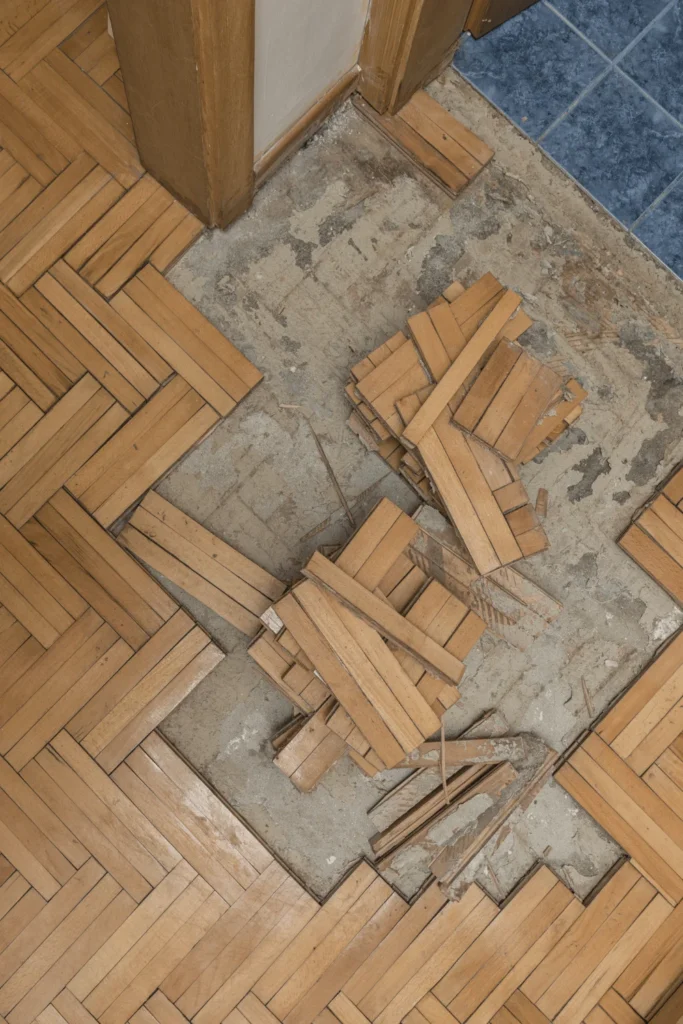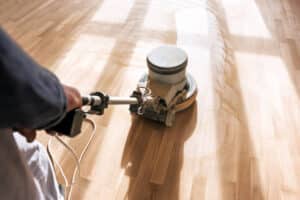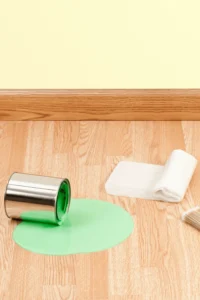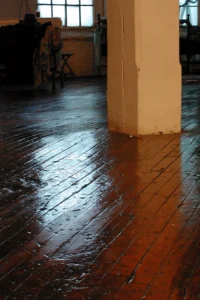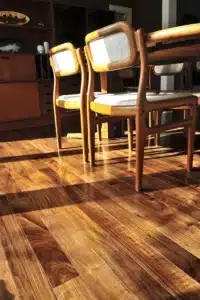Feel like your hardwood floor is a little haunted by strange creaks and shifts?
You might be dealing with signs of bad hardwood floor installation, be it from a first-time DIY project or– even worse– from a professional!
To thoroughly enjoy your floor’s longevity, durability, and beauty, you’ll want to make sure your floors are properly installed.
From ensuring proper alignment to adequate acclimation, every step in the installation process plays a vital role in the floor’s performance and appearance.
The good news? You’re here, detecting it as soon as possible. Let’s explore how to spot some common signs of signs of hardwood flooring problems, specifically when it comes to installation.
Signs of Bad Hardwood Floor Installation
It can be wildly disheartening to discover that your hardwood floors were installed wrong. But first, let’s make sure we’re diagnosing the problem properly. Here are some of the most common signs of bad hardwood floor installation:
Gaps Between Planks
When we talk about gaps between planks in hardwood flooring, we’re referring to visible spaces or openings between individual boards. These gaps can vary in size and can be quite noticeable, affecting both the appearance and functionality of the floor.
Causes
- Wood not properly acclimating to its environment before installation
- Sloppy craftsmanship and inattention to details during the installation process
- Using cheap materials
Solution: A qualified hardwood flooring professional should come in and figure out the root cause. The solution could be adjusting the spacing between planks, ensuring proper acclimation of the wood is crucial steps, or tackling underlying issues like moisture imbalances or subfloor irregularities is essential to prevent the gaps from making a comeback.
Cupping or Warping
Cupping or warping happens when the edges of hardwood planks curl upward or when the boards twist or bow.
Causes
- Improper installation techniques that fail to account for environmental conditions
- Moisture imbalance between the top and bottom surfaces of the hardwood planks
Solution: A qualified hardwood flooring professional will implement moisture control measures, like maintaining proper humidity levels in the home, which can help mitigate cupping or warping. In severe cases, you might need to professionally refinish may be necessary to restore the floors to their original condition.
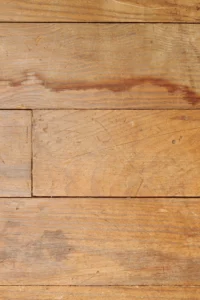
Buckling
Buckling is a more serious issue that occurs when hardwood floorboards lift or bulge away from the subfloor. This can lead to tripping hazards and structural damage if not addressed promptly.
Causes
- Excessive moisture exposure
- Inadequate subfloor preparation
Solutions: You might need to implement moisture mitigation strategies overall like repairing leaks or improving ventilation. In cases where buckling already happened, find a professional to repair or replace the affected boards to restore the integrity of the floors.
Squeaking or Loose Boards
Squeaking or loose boards are not only annoying but can compromise the stability and longevity of your hardwood floors.
Causes
- Inadequate fastening of the floorboards to the subfloor
- Improper subfloor preparation
- Fluctuations in humidity levels
Solutions: You’ll need to bring in a professional to reinforce fasteners or adhesive between the floorboards and subfloor to help eliminate squeaking or loose boards, or to help address any underlying subfloor issues like unevenness or moisture issues.
Peeling Finish
Peeling finish on hardwood floors makes hardwood flooring look cheaper and exposes the wood to potential damage and wear. (Not to mention having to clean unnecessary finish peeling that adds to your weekly vacuuming routine!)
Causes:
- Inadequate surface preparation before applying the finish
- Use of low-quality or incompatible finishing products
- Exposure to excessive moisture or temperature fluctuations
Solutions: A professional may need to strip away the old finish, and sand the surface to remove imperfections. They’ll then need to apply a new, high-quality finish that is compatible with the wood and environmental conditions.
Debris in the Finish
There’s nothing worse than your hardwood floor looking dirtier than it is because of unwanted debris trapped in the finish!
Causes:
- Failure to properly clean and prepare the surface before applying the finish
- Environmental factors like airborne debris or pet hair settling on the wet finish
Solutions: Correcting debris in the finish typically involves carefully sanding or scraping away the affected areas to remove the particles. Once it’s cleaned, a professional can refinish the surface with a new coat to restore its smooth and pristine appearance.

Poorly Sanded
Poor sanding of hardwood floors can result in an uneven surface, visible imperfections, and an overall lackluster finish.
Causes:
- Inadequate sanding technique or equipment
- Rushing through the sanding process without properly preparing the surface
- Failure to address inconsistencies or imperfections in the wood before applying the finish
Solutions: Rectifying poorly sanded floors requires thorough sanding to level the surface and remove any imperfections. This might involve using progressively finer grit sandpaper to achieve a smooth and uniform finish. Once it’s been properly sanded, your professional hardwood team can refinish your flooring to restore its natural beauty and durability.
Consequences of Hardwood Flooring Problems and Bad Installation
You might already be experiencing some of the consequences of hardwood flooring problems, which could impact the integrity and safety of your home. But (hopefully) if you’re only at the beginning of your hardwood floor problem, you might not yet see it:
Structural Damage
Improper installation and hardwood flooring problems can result in structural damage to your floors. You might see this manifest as:
- Sagging: When floorboards are not properly supported or installed, they may begin to sag over time, resulting in an uneven surface and compromised stability.
- Uneven surfaces: Gaps, cupping, or warping caused by bad installation can create uneven surfaces that not only affect the aesthetics of your floors but also pose safety risks.
- Instability: If left unaddressed, structural damage can lead to overall instability of the hardwood floors, making them prone to movement or shifting.
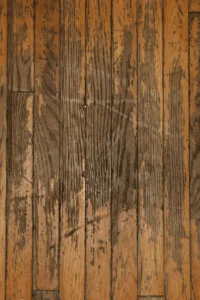
Shorter Lifespan
And unfortunately, seeing signs of bad hardwood floor installation in your home could cost you, both through premature replacements, and costly repairs.
Safety Hazards
This might have been what made you first notice the signs of bad hardwood floor installation to begin with! Tripping over uneven surfaces, gaps and loose boards are all common reasons why homeowners first realize there’s an issue to begin with.
Hire a Qualified Hardwood Flooring Professional
Qualified professionals possess the necessary knowledge, skills, and experience to perform proper hardwood floor installation and repairs. Their expertise ensures that installation issues are addressed effectively, minimizing the risk of future problems.
Professional installers follow industry best practices and guidelines, minimizing the risk of installation errors and maximizing the lifespan of your hardwood floors. A qualified flooring professional can help you can rest assured that the job will be done right the first time.
Our hardwood floor repair services can help diagnose, solve, and prevent hardwood floor problems from coming back! Whether you’re seeing:
- Signs of bad engineered hardwood floor installation
- Signs of mold under hardwood floors
- Signs of water damage on hardwood floors
- Prefinished hardwood flooring problems
We can help you maintain beautiful hardwood floors for years to come, whether through repairs, refinishing, installation, or even some guidance. Love your hardwood floors again!

